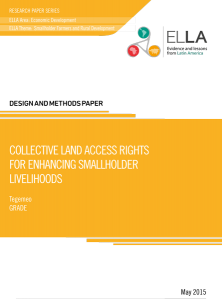Collective land access rights for enhancing smallholder livelihoods
| Año | : | 2015 |
|---|---|---|
| Autor/es | : | Timothy Njagi, Lilian Kirimi, Gerardo Damonte, Manuel Glave |
| Área/s | : | Desarrollo rural y agricultura, Recursos naturales, industrias extractivas y conflictos sociales |
[2015] NJAGI, Timothy; KIRIMI, Lilian; DAMONTE, Gerardo y Manuel GLAVE. Collective land access rights for enhancing smallholder livelihoods. ELLA. Economic Development, Smallholder Farmers and Rural Development, Design and methods paper.
Land liberalisation policies and programmes based on giving individual property rights implemented in the last decades have not produced the expected results in improving rural peasant and/or native livelihoods in Andean and African countries. Previous studies have found mixed results, with more recent literature showing that these programmes were ineffective in increasing productivity, input use or access to credit. On the contrary, emerging literature suggests that maintaining collective land access rights may have positive effects on rural livelihoods in particular for indigenous and peasant communities. Our study will investigate the effect of collective land access on smallholder livelihoods.
Therefore, our general research question is: Under which conditions does the maintenance of collective land access rights improve rural families’ livelihoods? To answer this question we will compare different sorts of collective land access rights functioning in four territories in Peru and Kenya to see under which conditions they achieve positive performances in improving livelihoods. This research is especially significant for countries, such as Peru and Kenya, where collective land access rights are common, and both have a significant amount of land under collective access rules.







